
Parsley or garden parsley is a species of flowering plant in the family Apiaceae, native to the central Mediterranean region, naturalized elsewhere in Europe, and widely cultivated as a herb, a spice, and a vegetable.

Symphoricarpos, commonly known as the snowberry, waxberry, or ghostberry, is a small genus of about 15 species of deciduous shrubs in the honeysuckle family, Caprifoliaceae. With the exception of the Chinese coralberry, S. sinensis, which is indigenous to western China, all species are native to North and Central America. The name of the genus is derived from the Ancient Greek words συμφορεῖν (sumphoreîn), meaning "to bear together", and καρπός (karpós), meaning "fruit". It refers to the closely packed clusters of berries the species produce.

Sphinx vashti, the Vashti sphinx, is a member of the family Sphingidae of moths. It is found in North America from British Columbia east to Manitoba, south to southern California, Nevada, central Arizona, New Mexico and western Texas.
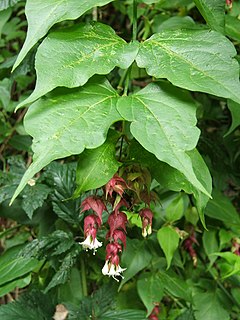
Leycesteria formosa, the Himalayan honeysuckle, flowering nutmeg, Himalaya nutmeg or pheasant berry, is a deciduous shrub in the family Caprifoliaceae, native to the Himalaya and southwestern China. It is considered a noxious invasive species in Australia, New Zealand, the neighboring islands of Micronesia, and some other places.

Vaccinium ovatum is a North American species of flowering shrub known by the common names evergreen huckleberry,winter huckleberry and California huckleberry.

Symphoricarpos mollis, with the common names creeping snowberry, Southern California snowberry, and trip vine, is a shrub in the Honeysuckle Family (Caprifoliaceae). It is found in western North America from British Columbia to California inland to Nevada and Idaho.

Symphoricarpos occidentalis, commonly called western snowberry or wolfberry, is a woody species of flowering plant in the honeysuckle family. Wolfberry is not to be confused with Lycium chinense and L. barbarum (goji), which are also known as wolfberry.
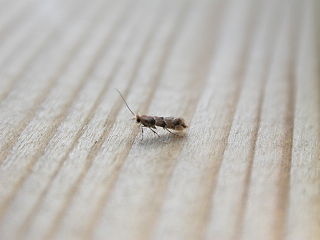
Phyllonorycter trifasciella is a moth of the family Gracillariidae. It is found in Western Europe.

Symphoricarpos orbiculatus, commonly called coralberry, buckbrush or Indian currant is a woody species of flowering plant in the honeysuckle family.

Symphoricarpos albus is a species of flowering plant in the honeysuckle family known by the common name common snowberry. It is native to North America, where it occurs across much of Canada and the northern and western United States.
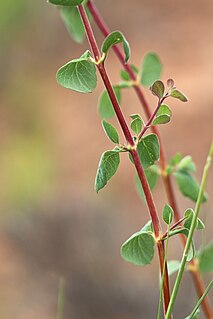
Symphoricarpos longiflorus is a species of flowering plant in the honeysuckle family known by the common names desert snowberry and fragrant snowberry. It is native to the western United States from the Great Basin to western Texas, as well as northwestern Mexico.

Symphoricarpos rotundifolius is a North American subshrub in the honeysuckle family, also known by the common name round-leaved snowberry.
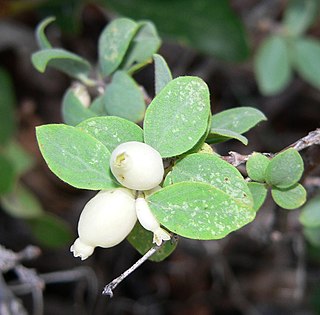
Symphoricarpos oreophilus is a North American species of flowering plant in the Caprifoliaceae, or honeysuckle family, known by the common name mountain snowberry. It has a wide distribution in western Canada, the United States, and northwestern Mexico. It is found in mountainous areas such as the Cascades, the Sierra Nevada, the Rockies, and the Sierra Madre Occidental from British Columbia to the Copper Canyon region of Chihuahua, from the coastal states as far inland as the Black Hills, the Oklahoma Panhandle, and trans-Pecos Texas.
Symphoricarpos palmeri, common name Palmer's snowberry, is a North American species of plants in the Honeysuckle Family. It has been found in the southwestern United States, as well as in the Mexican State of Chihuahua inside Basaseachic Falls National Park.
Symphoricarpos sinensis is an uncommon Chinese species of shrubs in the honeysuckle family. It has been found in the Provinces of Gansu, Guangxi, Hubei, Shaanxi, Sichuan, and Yunnan in central and southern China.
Symphoricarpos acutus, the sharpleaf snowberry, is a North American species of trailing shrubs in the honeysuckle family. It is native to the western United States.
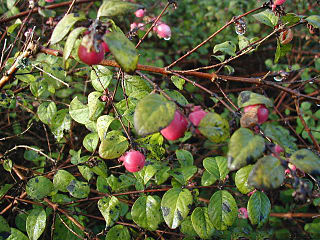
Symphoricarpos × chenaultii, the Chenault coralberry, is a northospecies (hybrid) group of shrubs in the honeysuckle family. It was grown in France in 1912 as a hybrid S. microphyllus × S. orbiculatus.
Symphoricarpos microphyllus, the pink snowberry, is a North American species of flowering plant in the honeysuckle family. It is widespread across much of Mexico from Chihuahua to Chiapas, and found also in Guatemala, Honduras, and the US State of New Mexico.
Symphoricarpos parishii, or Parish's snowberry, is a North American species of flowering plant in the honeysuckle family. It had been found in California, Nevada, Arizona, and Baja California.
Symphoricarpos guadalupensis, McKittrock's snowberry, is a rare North American species of plants in the honeysuckle family. It has been found only in South McKittrick Canyon in the Guadalupe Mountains of western Texas. This is inside Guadalupe Mountains National Park.
















